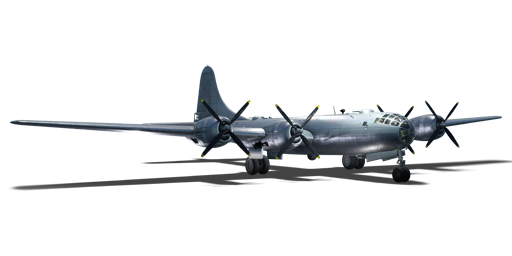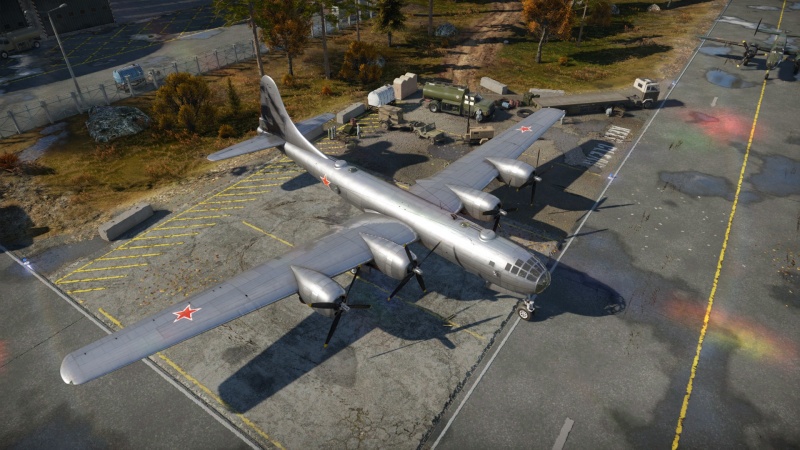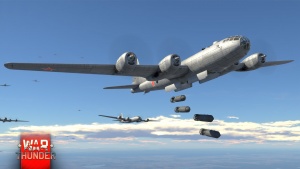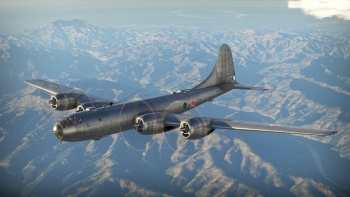Difference between revisions of "Tu-4"
(→Suspended armament: Updated) |
(Accidental usage of "B-29", when clearly this means the Tu-4, since the Tu-4 is higher BR and hits early jets and AA missiles.) (Tag: Visual edit) |
||
| Line 15: | Line 15: | ||
On the 3rd of August 1947 at the Tushino Aviation Day parade, three large B-29s overflew the crowd watching the air show. Western reporters quickly dismissed these three aircraft as the "stolen" B-29s from before. It was only a few minutes later, when a fourth aircraft joined the formation, that the Western analysts had realized their worst fear had come true: the Soviets have successfully reverse engineered the B-29 and now had the capability of striking European and American major targets from their home. | On the 3rd of August 1947 at the Tushino Aviation Day parade, three large B-29s overflew the crowd watching the air show. Western reporters quickly dismissed these three aircraft as the "stolen" B-29s from before. It was only a few minutes later, when a fourth aircraft joined the formation, that the Western analysts had realized their worst fear had come true: the Soviets have successfully reverse engineered the B-29 and now had the capability of striking European and American major targets from their home. | ||
| − | The '''{{Specs|name}}''', introduced in [[Update 1.59 "Flaming Arrows"]], is the last and most advanced propeller driven bomber in the Soviet tech tree. At first appearing to be a copy of the [[B-29A-BN|B-29]] in the US tech tree, the aircraft in actuality has many major differences upon closer inspection, which warrant its higher battle rating over its American brother. For starters, the aircraft's offensive and defensive capabilities are further bolstered by a larger bomb load utilizing larger Soviet bombs than its US counterpart, and the 12.7 mm turrets around the aircraft were all replaced with 23 mm turrets which pack a harder punch and extended range. The Tu-4 also differs over the B-29 by having stronger and more reliable engines, which counteract the added weight of the increased bomb load and stronger turrets. One must be wary when flying the | + | The '''{{Specs|name}}''', introduced in [[Update 1.59 "Flaming Arrows"]], is the last and most advanced propeller driven bomber in the Soviet tech tree. At first appearing to be a copy of the [[B-29A-BN|B-29]] in the US tech tree, the aircraft in actuality has many major differences upon closer inspection, which warrant its higher battle rating over its American brother. For starters, the aircraft's offensive and defensive capabilities are further bolstered by a larger bomb load utilizing larger Soviet bombs than its US counterpart, and the 12.7 mm turrets around the aircraft were all replaced with 23 mm turrets which pack a harder punch and extended range. The Tu-4 also differs over the B-29 by having stronger and more reliable engines, which counteract the added weight of the increased bomb load and stronger turrets. One must be wary when flying the Tu-4 however, as it often faces jets and early air-to-air missiles at its tier which can easily dispatch it. But when left unchecked, a fully loaded Tu-4 can completely annihlate enemy bombing targets and cripple their ticket count severely, swaying the match in favor of its team. |
== General info == | == General info == | ||
Latest revision as of 11:56, 17 March 2024
| This page is about the Soviet heavy bomber Tu-4. For other versions, see B-29/Tu-4 (Family). |
Contents
Description
Towards the end of WWII, the United States refused the request of the USSR to recieve B-29s under the Lend-lease program multiple times. Lacking the technology to create a proper strategic long range bomber to replace their aging (and limited) fleet of Pe-8 bombers, the USSR started looking for other solutions to modernize their bomber fleet. Their solution fell to them from the sky... multiple times, as three different B-29s would divert or crash land in the far Eastern USSR, and due to the USSR's neutrality in the Pacific War against Japan at that point, these bombers were kept despite demands from the US to return them. Stalin quickly ordered the reverse engineering of the three bombers into a new Soviet heavy bomber, and assigned the daunting task to Andrei Tupolev. The first aircraft was disassembled down to each screw to be studied, the second was repaired for flight testing, and the third, being the most minimally damaged, was left as a standard reference for the designers. In total, 900 factories and research institutes were involved in the project. The most significant change was in the engine department and armament, with the Tu-4 being powered by Soviet-built copies of the Wright R-3350 engines used in the B-29 and the .50 cal turrets replaced with NS-23 cannon turrets. After four years of hard work, alot of bureaucratic hurdles, and technological rushes, the first Tu-4 would take to the skies on May 19, 1947, with serial production being authorized to start immediately.
On the 3rd of August 1947 at the Tushino Aviation Day parade, three large B-29s overflew the crowd watching the air show. Western reporters quickly dismissed these three aircraft as the "stolen" B-29s from before. It was only a few minutes later, when a fourth aircraft joined the formation, that the Western analysts had realized their worst fear had come true: the Soviets have successfully reverse engineered the B-29 and now had the capability of striking European and American major targets from their home.
The Tu-4, introduced in Update 1.59 "Flaming Arrows", is the last and most advanced propeller driven bomber in the Soviet tech tree. At first appearing to be a copy of the B-29 in the US tech tree, the aircraft in actuality has many major differences upon closer inspection, which warrant its higher battle rating over its American brother. For starters, the aircraft's offensive and defensive capabilities are further bolstered by a larger bomb load utilizing larger Soviet bombs than its US counterpart, and the 12.7 mm turrets around the aircraft were all replaced with 23 mm turrets which pack a harder punch and extended range. The Tu-4 also differs over the B-29 by having stronger and more reliable engines, which counteract the added weight of the increased bomb load and stronger turrets. One must be wary when flying the Tu-4 however, as it often faces jets and early air-to-air missiles at its tier which can easily dispatch it. But when left unchecked, a fully loaded Tu-4 can completely annihlate enemy bombing targets and cripple their ticket count severely, swaying the match in favor of its team.
General info
Flight performance
| Characteristics | Max Speed (km/h at 9,100 m) |
Max altitude (metres) |
Turn time (seconds) |
Rate of climb (metres/second) |
Take-off run (metres) | |||
|---|---|---|---|---|---|---|---|---|
| AB | RB | AB | RB | AB | RB | |||
| Stock | 618 | 604 | 12000 | 33.4 | 35.0 | 4.7 | 4.6 | 1,500 |
| Upgraded | 665 | 641 | 30.4 | 32.0 | 10.5 | 6.5 | ||
Details
| Features | ||||
|---|---|---|---|---|
| Combat flaps | Take-off flaps | Landing flaps | Air brakes | Arrestor gear |
| ✓ | ✓ | ✓ | X | X |
| Limits | ||||||
|---|---|---|---|---|---|---|
| Wings (km/h) | Gear (km/h) | Flaps (km/h) | Max Static G | |||
| Combat | Take-off | Landing | + | - | ||
| 609 | 389 | 332 | 322 | 270 | ~4 | ~2 |
| Optimal velocities (km/h) | |||
|---|---|---|---|
| Ailerons | Rudder | Elevators | Radiator |
| < 340 | < 350 | < 290 | > 400 |
Survivability and armour
- 60 mm Bulletproof glass in front of the pilots.
- 6.5 mm Steel plates in front of the pilots.
- 6.5 mm Steel plates behind the pilots.
- 6.5 mm Steel plates in front of tail control tractions.
- 6.5 mm Steel plates boxing around rear dorsal gunner and beam gunners.
- 6.5 mm Steel plate behind the rear ventral turret.
- 60 mm Bulletproof glass in front of tail gunner.
- 6.5 mm Steel plate in front of tail gunner.
Do not be fooled of its nickname of "The Russian Death Star". Even with its powerful defensive armament, it does have weak spots.
While playing the Hunter F.1 or the Vautour IIA, it is easy to send this monster of an aircraft back to base with just one burst. Engaging in a head-on is recommended, as the pilots have little protection, usually knocking them both out.
However, the Tu-4 is a monster of an aircraft in terms of its profile and size, making it very easy to hit. Wings and the tail control are weak spots, so hitting the wings will result in severe wing damage on the Tu-4, forcing it to return to base or even sending it back to the hangar.
While flying the Sabres, try to aim for the fuel tanks in the wings. Most of the time, just set the fuel tanks ablaze, or even blowing off the wing, sending the foe back to the hangar.
Do not engage the Tu-4 from the six. Engaging the Tu-4 at its tail, especially from below, is asking for trouble. Always try to engage the Tu-4 from the top, or in head-ons, the fuselage turrets have dead zones when engaging from >~70 degrees.
Modifications and economy
Armaments
Suspended armament
The Tu-4 can be outfitted with the following ordnance:
- 40 x 100 kg FAB-100sv bombs (4,000 kg total)
- 40 x 250 kg FAB-250M-46 bombs (10,000 kg total)
- 12 x 500 kg FAB-500M-46 bombs (6,000 kg total)
- 20 x 500 kg FAB-500M-46 bombs (10,000 kg total)
- 8 x 1,000 kg FAB-1000M-44 bombs (8,000 kg total)
- 8 x 1,500 kg FAB-1500M-46 bombs (12,000 kg total)
- 4 x 3,000 kg FAB-3000M-46 bombs (12,000 kg total)
Defensive armament
The Tu-4 is defended by:
- 2 x 23 mm NR-23 cannons, front dorsal turret (275 rpg = 550 total)
- 2 x 23 mm NR-23 cannons, front ventral turret (250 rpg = 500 total)
- 2 x 23 mm NR-23 cannons, rear dorsal turret (275 rpg = 550 total)
- 2 x 23 mm NR-23 cannons, rear ventral turret (500 rpg = 1,000 total)
- 2 x 23 mm NR-23 cannons, tail turret (275 rpg = 550 total)
Usage in battles
Like most planes of its class, the Tu-4 relies on its defensive turrets for aerial combat. A few good hits from its 10 x 23 mm guns can send an attacker back to base, with critical damage or, if not, credit the player with the victory. Maxing out the crew stats is a good idea, it will allow the player to focus more on flying while the AI does the gunning. Don't get too arrogant, remember, the Tu-4 is a huge plane. It is easy to hit, and as mentioned above, especially when the opponents could be jets.
All in all, pay attention to the aircraft's surroundings. The Tu-4 can easily net the team a win so don't let the feeling of invincibility get imbued, or the only reward will be a fiery end.
With this bomber's high battle rating, you should be actively looking out for enemy vehicles. It is possible for an attacker to have a relative closing speed of over 1,000 km/h. Relying solely on the spotting system will allow some fighters to get so close it will be impossible for you to react. It is especially common for the enemy to approach either in a 30° cone straight ahead or to trail behind and below you, generally outside gun range before pulling up sharply.
When first starting with this aircraft, the payload option is 40 x 100 kg bombs which are able to destroy numerous bases. One of the best ways to maximize the payload's effectiveness, 15 x 100 kg bombs are needed for one base. The A.I. gunners will be able to defend the plane as bombs are dropped from the bombsight until switching back to the pilot seat, ready to head to next objective. The best option for base bombing is the 8 x 1,500 kg payload. A single bomb will be enough to destroy a base, provided you do not miss.
Once the Tu-4's bombing run is complete, start descending towards the friendly airfield; enemy fighters will be hunting for the Tu-4, so be more alert. The Tu-4 has a very powerful defensive system installed with 5 turrets, each with two 2 x 23 mm cannons, so the Tu-4 should be able to defend itself reasonably well. If you believe that landing would be putting the aircraft in grave danger, it is worth considering to instead stay high and shoot down approaching fighters, calling out your position will often lower the stigma associated with this action.
Do not rely on the AI gunners. The Tu-4 will often face powerful jets including Hunter F.1s and F-86F-2s. These adversaries are usually experienced and will not foolishly tail the bomber for long and try to engage at ranges greater than 1 km or engage in a head-on pass. These manoeuvres render the AI gunners largely useless. Laying down a stream of 23 mm rounds is recommended, but beware of jamming. Hits can be scored within 1.5 - 2 km, if somebody is tailing the Tu-4 or engaging in a head-on pass, they can also occur at greater ranges. Combine the turret shooting with a defensive style of flying to utilize it to its full potential; the Tu-4 offers good handling for its size. Be very careful when putting the Tu-4 into a dive. It is just as prone as any other aircraft to suffering structural damage if its limitations are exceeded. Do not rely on flaps to slow down, their weak construction will let you down.
The two most dangerous opponents of the Tu-4 are the S.O.4050 Vautour IIA and the Hunter F.1. With their 30 mm cannons, one burst will be devastating against the Tu-4. The F-86F-2 is also a dangerous opponent, with four 20 mm cannons with a very high velocity and rate of fire.
When down-tiered, the most dangerous opponents are the Me 163 B, the Me 262 C-2b and the R2Y2 KAIs. All equipped with 30 mm cannons, they are able to send the Tu-4 back to the hangar within one burst. The Me 163 and Ki-200's extreme mobility are something to be wary of. It isn't uncommon for bomber pilots to lose track of the attacker after a fly by.
Don't underestimate the other Sabres, such as the F-86F-40 and the CL-13A. Their 12.7 mm machine guns can do a lot of damage, crippling or setting the Tu-4 afire, which could end the match for the plane there.
Do not consider any enemy bomber or attacker as a neutral or even friendly party. It is quite common for Canberra's or even B-57's to try and engage you if the opportunity presents itself.
Manual Engine Control
| MEC elements | ||||||
|---|---|---|---|---|---|---|
| Mixer | Pitch | Radiator | Supercharger | Turbocharger | ||
| Oil | Water | Type | ||||
| Controllable | Controllable Auto control available |
Not controllable Not auto controlled |
Controllable Not auto controlled |
Combined | Controllable 1 gear |
Auto controlled |
Pros and cons
Pros:
- Very strong and fast climber once flight performance modifications have been purchased
- Very heavy payload (up to 12,000 kg / 26,500 lbs)
- All payload options are internal and has next to no effect on flight performance
- Offers effective defensive 23 mm turrets that have very few dead zones
- Gunners are located separately from the gun turret with the exception of the tail turret
- Lots of ammo for defensive armaments
Cons:
- Does not offer any payload modification immediately, unlike the B-29
- Prone to fires and wing damage
- Will be ripped to shreds by cannons with a calibre of 20 mm and beyond, especially the 30 mm MK 108 and the 30 mm ADEN/30 mm DEFA 541
- Matchmaking will make this aircraft face early jets
- Unable to reliably defend itself from multiple opponents attacking at once from multiple directions
- Huge aircraft, making it easy to spot from distance and making it close to impossible to miss
- Has a low dive top speed
- Takes a while to reach an optimal altitude
- Having altitude doesn't do much because jets can reach you in a matter of minutes
- Landing gear takes a long time to deploy and retract
- Wings are considered weak spots, damaged wings will hinder the plane's control
- Flaps are one piece, making it frequent for a wing to lose the whole piece at once. This can affect lift significantly.
- Can be hard to handle during landing, especially on short runways.
- Takes a while to reach the ground (in one piece)
- Against missiles you are hopeless
History
The Soviet Tu-4 strategic bomber is a copy of the B-29 with more powerful engines and armament. The USSR did not possess strategic aviation capacity in 1945 while having a great requirement for it as the Cold War was about to begin. Several B-29s were forced to land in Soviet territory near Japan after suffering mechanical failures related to the engine cowl flaps, and the B-29s along with their crews were captured on landing. The B-29's that ended up in the hands of Soviet engineers seemed to be a technological miracle and a vast gap between the long-range bomber technologies of the US and the USSR was soon discovered. This lead to a hurried cloning effort while created the Tu-4, a Soviet copy of the American bomber with a few modifications. The Soviets copied the bomber so closely that some Tu-4s had bullet hole patches from the B-29 that weren't meant to be there.
Media
- Skins
- Videos
See also
Links to the articles on the War Thunder Wiki that you think will be useful for the reader, for example:
- reference to the series of the aircraft;
- links to approximate analogues of other nations and research trees.
External links
- [Devblog] B-29 Superfortress/Tu-4 – the new face of the giant
- Official data sheet - more details about the performance
| Tupolev Design Bureau (Ту́полев Опытное конструкторское бюро) | |
|---|---|
| Bombers | TB-3M-17-32 · SB 2M-100 · SB 2M-103 MV-3 · SB 2M-103 · SB 2M-103U · SB 2M-103U MV-3 · SB 2M-105 |
| Tu-2 · Tu-2S · Tu-2S-44 · Tu-2S-59 · Tu-4 | |
| Arkhangelsky Bomber | Ar-2* |
| Strike Aircraft | Tu-1 |
| Jet Bomber | Tu-14T |
| Export | ␗SB 2M-103U · ␗Tu-2S-44 · ␗Tu-4 |
| ◔Tu-2S-59 | |
| * While Andrei Tupolev was imprisoned, Alexander Arkhangelsky, second in command at Tupolev OKB was able to append his name to the final production series of the SB bomber. | |
| USSR bombers | |
|---|---|
| SB and Ar | SB 2M-100 · SB 2M-103 · SB 2M-103 MV-3 · SB 2M-103U · SB 2M-103U MV-3 · SB 2M-105 · Ar-2 |
| Yer-2 (petrol) | Yer-2 (M-105) · Yer-2 (M-105) TAT · Yer-2 (M-105R) TAT · Yer-2 (M-105R) LU |
| Yer-2 (diesel) | Yer-2 (ACh-30B) (e) · Yer-2 (ACh-30B) (l) |
| Tu | Tu-2 · Tu-2S · Tu-2S-44 · Tu-2S-59 · Tu-4 |
| Pe | Pe-2-1 · Pe-2-31 · Pe-2-83 · Pe-2-110 · Pe-2-205 · Pe-2-359 · Pe-8 |
| IL | DB-3B · IL-4 |
| Po | Po-2 · Po-2M |
| Other | MBR-2-M-34 · TB-3M-17-32 · Yak-4 · Be-6 |
| Lend-Lease | ▂PBY-5A Catalina · ▂Hampden TB Mk I · ▂A-20G-30 · ▂B-25J-30 |







